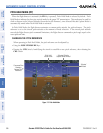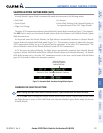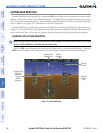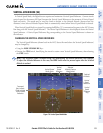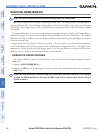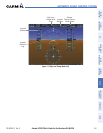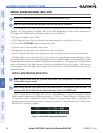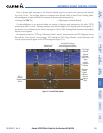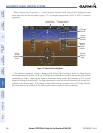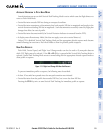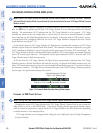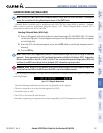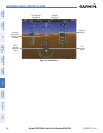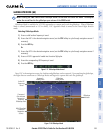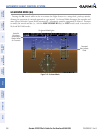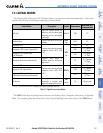
Garmin G1000 Pilot’s Guide for the Beechcraft A36/G36
190-00595-01 Rev. B
344
AUTOMATIC FLIGHT CONTROL SYSTEM
SYSTEM
OVERVIEW
FLIGHT
INSTRUMENTS
EIS
AUDIO PANEL
& CNS
FLIGHT
MANAGEMENT
HAZARD
AVOIDANCE
AFCS
ADDITIONAL
FEATURES
APPENDICESINDEX
When a descent leg is captured (i.e., vertical deviation becomes valid), Vertical Path Tracking becomes
active and tracks the descent profile (Figure 7-12). An altitude capture mode (‘ALTS’ or ‘ALTV’) is armed as
appropriate.
Required
Vertical
Speed
Indicator
Vertical
Deviation
Indicator
VNV Target
Altitude
Terminal
Phase of
Flight
GPS is
Selected
Navigation
Source
Figure 7-12 Vertical Path Tracking Mode
VNV Target Altitude
Capture Armed
Vertical Path
Tracking Active
If the altimeter barometric setting is adjusted while Vertical Path Tracking is active, the flight director
increases/decreases the descent rate by up to 500 fpm to re-establish the aircraft on the descent path (without
commanding a climb). Adjusting the altimeter barometric setting creates discontinuities in VNV vertical
deviation, moving the descent path. For large adjustments, it may take several minutes for the aircraft to re-
establish on the descent path. If the change is made while nearing a waypoint with a VNV Target Altitude,
the aircraft may not re-establish on the descent path in time to meet the vertical constraint.



